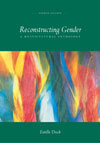 |
1 |  | 
According to Don Sabo in Reading 61 (Masculinities and Men's Health), men's health is determined by both biological and social factors. |
|  | A) | True |
|  | B) | False |
 |
 |
2 |  | 
According to Evelyn Barbee and Marilyn Little in Reading 62 (Health, Social Class, and African-American Women), while African-American women are no longer subjected to forced sterilization, they have few reproductive rights. |
|  | A) | True |
|  | B) | False |
 |
 |
3 |  | 
In Reading 63 (Reproductive Issues are Essential Survival Issues for the Asian-American Communities), author Connie Chan describes her good fortune that the health center where she worked provided counseling about birth control and abortion services. |
|  | A) | True |
|  | B) | False |
 |
 |
4 |  | 
In Reading 63 (Reproductive Issues Are Essential Survival Issues for the Asian-American Communities), author Connie Chan suggests that women's reproductive rights are actually community issues. |
|  | A) | True |
|  | B) | False |
 |
 |
5 |  | 
According to Sandra Steingraber in Reading 64 (Why the Precautionary Principle? A Meditation on Polyvinyl Chloride [PVC] and the Breasts of Mothers), human breast milk is the most contaminated of all human foods. |
|  | A) | True |
|  | B) | False |
 |
 |
6 |  | 
In Reading 65 (Does Silencio = Muerte? Notes on Translating the AIDS Epidemic), author Rafael Campo notes that some Latino/as view AIDS as a price to pay for a better life. |
|  | A) | True |
|  | B) | False |
 |
 |
7 |  | 
Hormones are the safest, yet the most expensive, way to alter one's body, according to Kai Wright in Reading 66 (To Be Poor and Transgender). |
|  | A) | True |
|  | B) | False |
 |
 |
8 |  | 
In Reading 61 (Masculinities and Men's Health), author Don Sabo's thesis is that: |
|  | A) | traditional masculinity can be dangerous to men's health |
|  | B) | traditional masculinity can contribute to men's health |
|  | C) | masculine behaviors encourage healthier, more active lifestyles |
|  | D) | b and c |
 |
 |
9 |  | 
According to Evelyn Barbee and Marilyn Little in Reading 62 (Health, Social Class, and African-American Women), which of the following statements describes the relationship between HIV/AIDS and African-American women? |
|  | A) | Case definitions of AIDS are based on a male profile. |
|  | B) | African-America women do not contract AIDS as often as African-American men do. |
|  | C) | Hardly any African-American women are exposed to HIV through IV drug use. |
|  | D) | African-American women have less access to health care than do the men in their communities. |
 |
 |
10 |  | 
In Reading 64 (Why the Precautionary Principle? A Meditation on Polyvinyl Chloride [PVC] and the Breasts of Mothers), author Sandra Steingraber's interest in this issue is inspired by her role as each of the following EXCEPT: |
|  | A) | mother |
|  | B) | scientist |
|  | C) | cancer survivor |
|  | D) | cancer researcher |
 |
 |
11 |  | 
In Reading 65 (Does Silencio = Muerte? Notes on Translating the AIDS Epidemic), which of the following is NOT suggested by the author as contributing to the silence about AIDS in Latino/a communities? |
|  | A) | homophobia |
|  | B) | Catholicism |
|  | C) | absence of free clinics in Latino/a communities |
|  | D) | lack of economic prospects |
 |
 |
12 |  | 
According to Kai Wright in Reading 66 (To Be Poor and Transgender), transgender individuals are typically all of the following EXCEPT: |
|  | A) | drag performers |
|  | B) | heterosexual cross-dressers |
|  | C) | people who live in a gender other than the one assigned to them at birth |
|  | D) | people who are confused about which gender they are because they are hermaphrodites |
 |



 2006 McGraw-Hill Higher Education
2006 McGraw-Hill Higher Education